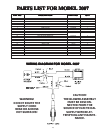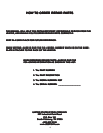
11
Creosote - Formation and Need for RemovalCreosote - Formation and Need for Removal
Creosote - Formation and Need for RemovalCreosote - Formation and Need for Removal
Creosote - Formation and Need for Removal
When wood is burned slowly, it produces tar and other
organic vapors, which combine with expelled moisture to
form creosote. The creosote vapors condense in the rela-
tively cool chimney flue of a slow burning fire. As a result,
creosote residue accumulates on the flue lining. When ig-
nited this creosote makes an extremely hot fire.
The chimney connector and chimney should be inspected at
least twice monthly during the heating season to determine
if a creosote buildup has occurred.
If creosote has accumulated, it should be removed. Failure to
remove creosote may cause a house fire. Creosote may be
removed by using a chimney brush or other commonly
available materials.
Chimney fires burn very hot. If the chimney connector should
glow red, immediately call the fire department, then reduce
the fire by closing the damper and pour a large quantity of
coarse salt, baking soda or cool ashes on top of the fire in
the firebox.
CAUTION:CAUTION:
CAUTION:CAUTION:
CAUTION: A chimney fire may cause ignition of
wall studs or rafters which you thought were a safe distance
from the chimney. If you have a chimney fire, have your
chimney inspected by a qualified person before using again.
CHIMNEY MAINTENANCECHIMNEY MAINTENANCE
CHIMNEY MAINTENANCECHIMNEY MAINTENANCE
CHIMNEY MAINTENANCE
SERSER
SERSER
SER
VICE HINTSVICE HINTS
VICE HINTSVICE HINTS
VICE HINTS
Do not expect a heater to draw. It is the chimney that creates
the draft. Smoke spillage into the house or excessive buildup
of water or creosote in the chimney are warnings that the
chimney is not functioning properly. Correct problem before
using heater. Possible causes are:
The connector pipe may push into the chimney too far,
stopping the draft. (Fig. 8)
Do not connect two heaters into the same chimney flue.
The chimney used for a heater must not be used to
ventilate the cellar or basement. If there is a cleanout
opening at the base of the chimney, It must be closed
tightly.
1.
2.
3.
4.
5.
If the chimney is operating too cool, water will condense
in the chimney and run back into the stove. Creosote
formation will be rapid and may block the chimney.
Operate the heater at a high enough fire to keep the
chimney warm preventing this condensation.
If the fire burns well but sometimes smokes or burns
slowly, it may be caused by the chimney top being lower
than another part of the house or a nearby tree. The wind
blowing over a house or tree, falls on top of the chimney
like water over a dam, beating down the smoke. The top
of the chimney should be at least 3 feet above the roof
and be at least to 2 feet higher than any point of the roof
within 10 feet (Fig. 6).
OPERAOPERA
OPERAOPERA
OPERA
TING INSTRTING INSTR
TING INSTRTING INSTR
TING INSTR
UCTIONSUCTIONS
UCTIONSUCTIONS
UCTIONS
Wood FuelWood Fuel
Wood FuelWood Fuel
Wood Fuel
Use Hardwood that has been split and air-dried to obtain
maximum burning efficiency.
Lighting InstructionsLighting Instructions
Lighting InstructionsLighting Instructions
Lighting Instructions
1. Open door and place paper and kindling in the
firebox.
2. Light the fire and close the doors until the kindling
is burning.
3. Open the doors and add fuel as desired.
Extended OperationExtended Operation
Extended OperationExtended Operation
Extended Operation
1. Fuel should be added in small amounts to give more
complete combustion and uniform room tempera
ture.
2. Empty the ashes regularly. Do not allow ashes to
build up. Dispose of hot ashes properly in a metal
container with a lid.
WARNING!WARNING!
WARNING!WARNING!
WARNING!
NEVER STORE FLAMMABLE LIQUIDS,NEVER STORE FLAMMABLE LIQUIDS,
NEVER STORE FLAMMABLE LIQUIDS,NEVER STORE FLAMMABLE LIQUIDS,
NEVER STORE FLAMMABLE LIQUIDS,
ESPECIALLY GASOLINE. IN THEESPECIALLY GASOLINE. IN THE
ESPECIALLY GASOLINE. IN THEESPECIALLY GASOLINE. IN THE
ESPECIALLY GASOLINE. IN THE
VICINITY OF THE HEATER.VICINITY OF THE HEATER.
VICINITY OF THE HEATER.VICINITY OF THE HEATER.
VICINITY OF THE HEATER.
CAUTION!CAUTION!
CAUTION!CAUTION!
CAUTION!
OVERFIRING THE APPLIANCE MAYOVERFIRING THE APPLIANCE MAY
OVERFIRING THE APPLIANCE MAYOVERFIRING THE APPLIANCE MAY
OVERFIRING THE APPLIANCE MAY
CAUSE A HOUSE FIRE. IF A UNIT ORCAUSE A HOUSE FIRE. IF A UNIT OR
CAUSE A HOUSE FIRE. IF A UNIT ORCAUSE A HOUSE FIRE. IF A UNIT OR
CAUSE A HOUSE FIRE. IF A UNIT OR
CHIMNEY CONNECTOR GLOWS, YOUCHIMNEY CONNECTOR GLOWS, YOU
CHIMNEY CONNECTOR GLOWS, YOUCHIMNEY CONNECTOR GLOWS, YOU
CHIMNEY CONNECTOR GLOWS, YOU
ARE OVERFIRING.ARE OVERFIRING.
ARE OVERFIRING.ARE OVERFIRING.
ARE OVERFIRING.
CAUTION!CAUTION!
CAUTION!CAUTION!
CAUTION!
NEVER USE GASOLINE, GASOLINE-TYPENEVER USE GASOLINE, GASOLINE-TYPE
NEVER USE GASOLINE, GASOLINE-TYPENEVER USE GASOLINE, GASOLINE-TYPE
NEVER USE GASOLINE, GASOLINE-TYPE
LANTERN FUEL, KEROSENE, CHARCOALLANTERN FUEL, KEROSENE, CHARCOAL
LANTERN FUEL, KEROSENE, CHARCOALLANTERN FUEL, KEROSENE, CHARCOAL
LANTERN FUEL, KEROSENE, CHARCOAL
LIGHTER FLUID, OR FLAMMABLELIGHTER FLUID, OR FLAMMABLE
LIGHTER FLUID, OR FLAMMABLELIGHTER FLUID, OR FLAMMABLE
LIGHTER FLUID, OR FLAMMABLE
LIQUIDS TO START OR "FRESHEN UP" ALIQUIDS TO START OR "FRESHEN UP" A
LIQUIDS TO START OR "FRESHEN UP" ALIQUIDS TO START OR "FRESHEN UP" A
LIQUIDS TO START OR "FRESHEN UP" A
FIRE IN THE HEATER.FIRE IN THE HEATER.
FIRE IN THE HEATER.FIRE IN THE HEATER.
FIRE IN THE HEATER.
WARNING!WARNING!
WARNING!WARNING!
WARNING!
OPERATE ONLY WITH THE FEED AND ASHOPERATE ONLY WITH THE FEED AND ASH
OPERATE ONLY WITH THE FEED AND ASHOPERATE ONLY WITH THE FEED AND ASH
OPERATE ONLY WITH THE FEED AND ASH
DOORS FULLY CLOSED.DOORS FULLY CLOSED.
DOORS FULLY CLOSED.DOORS FULLY CLOSED.
DOORS FULLY CLOSED.


















